Concussion: Post-Crash Recovery Phase 4, Getting Close to Normal
Related: concussion, cycling, health, heart rate, road biking, State of Utah, Zion National Park
Legal disclaimer: Since we are not doctors, never follow anything based on health-related topics on this or related sites without first consulting with your doctor or other trusted health professional. OTOH, the study of brain injuries is at best in its infancy, like studying outer space with primitive telescopes.
This page contains observations during the final stretch. It begins with physiological normalcy, as determined subjectively as well as objectively (MRHR as per April 17 entry), but as yet with stamina impairments (still a need for naps and early bed time).
Thank you to supportive readers, and especially my loyal subscribers. The latter are critically important to me as I recover, and I am grateful to them. I also want to thank OWC / MacSales.com and B&H Photo for their ongoing support as I work through this.
For context and additional interest and to test recovery for computer work, I am including images shot during each day.
Continued from Concussion Recovery Phase 3.
April 19, 34 days after crash, 29 days after ER visit #2: calibrating my active/sleep requirements
I woke (alarm) at 6 AM just to avoid the chance of an unfriendly ranger (“no sleeping overnight”). I would have rather slept till 8 AM, which is about when the tourists start arriving. This will require a mid-day nap to compensate; post-concussion my body really keeps score on sleep. Dawn was dull, so I wrote up the prior two days, below.
I took from about 7 AM to 11 AM to process images and write up the posts below and Cycling in Zion National Park. The test was successful but typical as noted yesterday: I felt ready for a nap when done, indeed it was a demanding need. This is consistent with the 3-4 hour effort requiring a 1-2 hour nap, depending on the prior day/night’s rest and the activity. As with the 3 prior days, a quick nap turned into 3 hours which in general is very unlike myself. So something is going on with the sleep cycle; it indicates a deficit in rest presumably.
April 18, 33 days after crash: pushing it requires rest
Today, I awoke too early which seems to be too often the case with disrupted sleep. While I had such issues pre-concussion, sleep seems more important but more variable and less predictable (e.g., waking up wide awake around 3 AM). It’s not a big issue and I assume it will settle down over time.
I awoke at 6:30 AM or so and should have thought better of it, but I wanted to spend the day photographing, after having cycled yesterday to explore the park, and having done no “real” photography. The cabin was 26°F / -3°C , but I was comfortable most all of the night as my body was generating a lot of heat from the prior day’s vigorous cycling.
I first took care of email (coverage is spotty but one learns to work with a crummy 3G or 4GB signal), then drove into Zion National Park where I hiked/photographed from about 9 AM to 12 PM. While I felt fine, 3 hour efforts are still demanding post-concussion; a short lunch turned into a 2+ hour nap as I really needed the rest. Around 3:30 I felt refreshed, and I went out to shoot again, until about 7 PM. Both hikes involved short but steep hikes and part of that was testing my balance—no issues. But after the hike, I again felt I needed rest and was about ready for bed. That’s the pattern. National Parks are unfriendly in one key way:they allow no roadside sleeping in vehicle, the campgrounds are crowded and always full as well as being a noisy mix of RVers with generators and tent campers, with car doors slamming all night, among other headaches. To find an area to sleep, I was forced to drive out of the park, ending up back in Zion to the northwest, in Kolob Canyons, where I was just too tired to continue, so I slept there anyway and was not hassled.
Normal function seemingly, but without stamina
In general, I’m finding that any activity (cycling, hiking, driving, computer) feels more or less normal, but that I tire easily in terms of mental efforts,.
For example, a ride that feels great and is well within my physical fitness says “sleep now!” as soon as I get off the bike. In general I’d say that 3-4 hours of activity demand an about 2 hour nap unless I am totally rested from the prior day, in which case it is 30-60 minute nap. There is clearly an effort/recovery ration of about 3:1 (one hour reset/nap for every hour of activity with significant mental effort).
Evaluating stress
I’m not a big selfie-taker; generally I have to remind myself to get one a day when traveling. When I take them it is generally to remind myself of place/time/gear/etc.
Yet under conditions of recovery from a concussion, or any stressful event, it seems to me that selfies can reveal mental state. What do you think? Try it on yourself.
My thinking is that aiming for low-stress days is key to full recovery from a concussion (worthy of scientific inquiry). Stress is never good for anything in the body, so when the brain is weak, it seems to me that the best recovery will result, in part, from the lowest stress. This is one reason why I have pushed off the daily grind—I want to come back as strong as before.
Continues below...
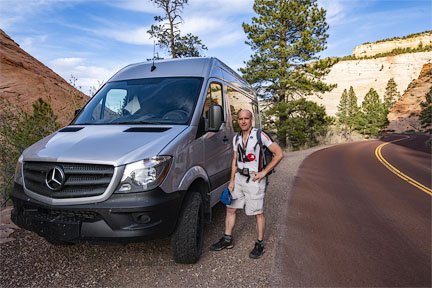
NIKON D850 + Nikon AF-S 14-24mm f/2.8G ED @ 24mm
[low-res image for bot]
From the selfies below, my assessment of myself, is that I am relaxed and content and happy, with confidence and focus returning as well.
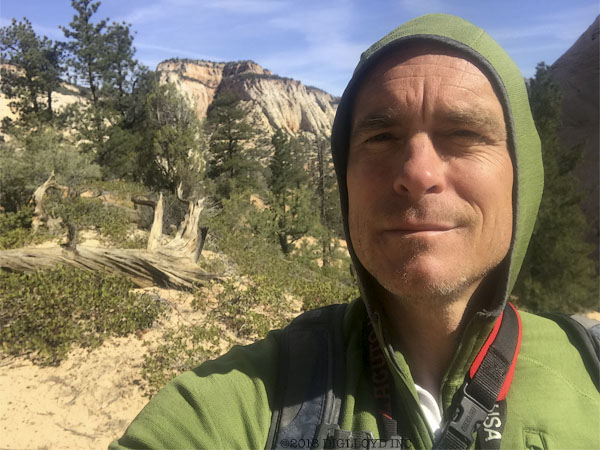
iPhone 7 Plus + iPhone 7 Plus front camera 2.87mm f/2.2 @ 32mm equiv (2.9mm)
[low-res image for bot]
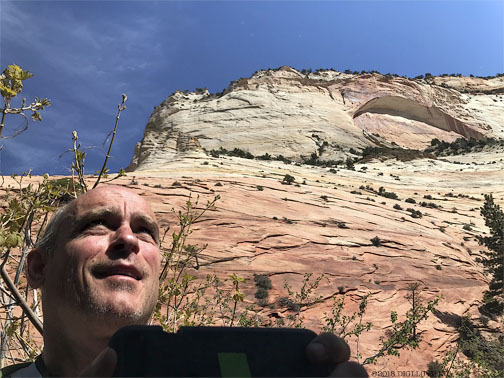
iPhone 7 Plus + iPhone 7 Plus back dual camera 3.99mm f/1.8 @ 28mm equiv (4mm) selfie
[low-res image for bot]
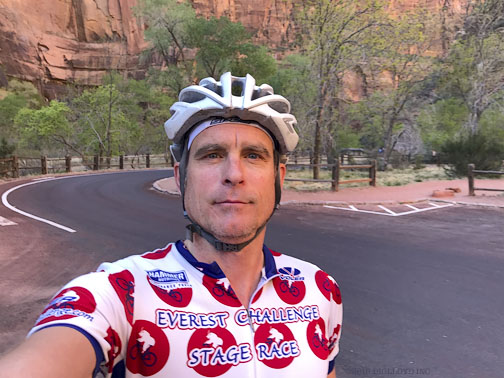
iPhone 7 Plus + iPhone 7 Plus back dual camera 3.99mm f/1.8 @ 28mm equiv (4mm) selfie
[low-res image for bot]

iPhone 7 Plus + iPhone 7 Plus back dual camera 6.6mm f/2.8 @ 57mm equiv (6.6mm) selfie
[low-res image for bot]
April 17, 32 days after crash: heart rate returns to normal levels (finally!!!)
Morning resting heart rate
I woke this morning with my Morning Resting Heart Rate (MRHR) of 41-46 at an elevation of 7300' / 2240m) which is 7 beats lower than readings a week ago. MRHR is a strong indicator of physiological rest and low stress level; I’ve monitored it for many years.
Thus this morning’s MRHR confirms what I had concluded 2-3 days ago about being back to physiological normal. While I do not have a blood pressure cuff with me, I’d bet my blood pressure is back to its normal of about 116/68 (versus as high as 170/115 at 5 days after the crash).
MRHR is a fail-safe indicator, but it is personal; track your own in order to know what normal is.
Next up is checking cognitive recovery. I’ve done some preliminary testing with some computer work that is relatively easy, like adding some pictures to prior days entries; doing that requires (for me) more and sustained attention than reading or writing. These tests are promising, so I think I am getting close to doing my usual photographic work, at least for a few hours.
Biking Zion
Given the promising low morning heart rate and not being familiar with Zion, I resolved to explore Zion National Park on my bicycle, a bit tricky given that the mile-long tunnel from the east does not allow bicycles, and the main canyon does not allow cars (unless staying at the lodge). But I did not know how long or difficult the tunnel traversal would be (an up to 15 minute wait it seems).
First I looped between the eastern side between the entrance station and the tunnel to check out locations for photography the next day. And then I took a short nap in the sun.
Next, I drove through the tunnel and parked just past it, then biked down the steep switchbacks to the junction with the main canyon road. I biked up this once, taking iPhone panoramas, then down, the up at an aggressive pace, then back up the steep switchbacks.
At the end of the day, I drove back through the tunnel and up North Fork onto dirt (now feeling very tired at 8 PM). I stayed there overnight, and even with temperatures dropping to 26°F inside the van I was plenty warm, my body generating a lot of heat, a good sign of physiological response to fatigue (based on past experience)—so I was not cold until very early morning and then only slightly so. Starting the van and blasting its heater along with a 1500 watt space heater got things warm quickly.
See also Cycling Zion National Park, Eastern Side and Main Canyon.

iPhone 7 Plus + iPhone 7 Plus back camera 3.99mm f/1.8 @ 28mm equiv (4mm)
[low-res image for bot]
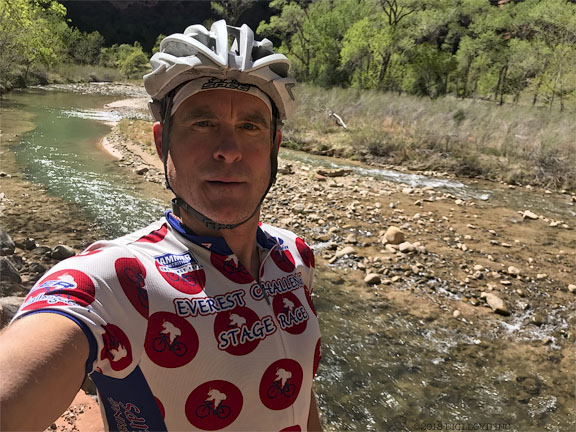
iPhone 7 Plus + iPhone 7 Plus back dual camera 3.99mm f/1.8 @ 28mm equiv (4mm) selfie
[low-res image for bot]
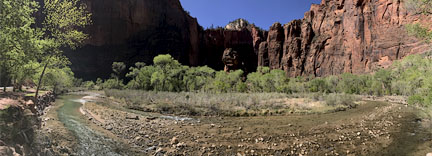
iPhone 7 Plus + iPhone 7 Plus back camera 3.99mm f/1.8 @ 28mm equiv (4mm)
[low-res image for bot]



